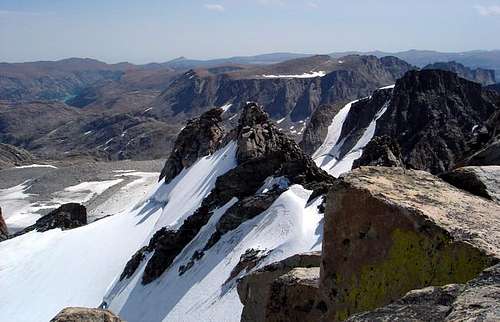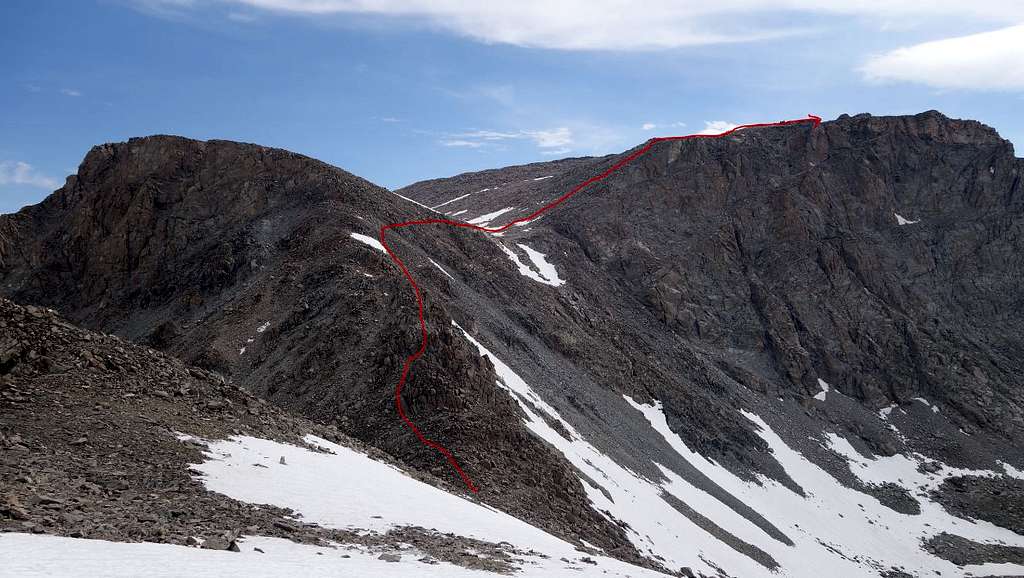-
 6857 Hits
6857 Hits
-
 74.92% Score
74.92% Score
-
 5 Votes
5 Votes
|
|
Mountain/Rock |
|---|---|
|
|
43.10923°N / 109.55534°W |
|
|
Hiking, Scrambling, Skiing |
|
|
Spring, Summer, Fall |
|
|
13198 ft / 4023 m |
|
|
Overview
Bete Noire (or Brown Cliffs HP) is a gentle 13er in the core group of peaks of the northern Wind River Range in Wyoming. It sits at an elevation of 13198 feet about 1.78 miles east of Indian Pass as the crow flies. Of all the 35 Wyoming 13ers, this is probably one of the least likely to have random backpackers or hikers stumbler onto its summit simply because it sits in a spot no one really ventures to (see the list here). The only place it's really visible from any trail is right at Indian Pass itself, but most will overlook this peak when standing at the pass in favor of more dramatic peaks in other directions. It's important to note the summit plateau has two distinct hills, of which the southern is the highest. A handful of pedestal shaped outcrops top this southern hill and are within a few feet of one another...all are easy class 2 to stand on top of. As of July 2020 there was no summit register.

Getting There
Use the Elkhart Park Trailhead accessed from Pinedale on the west side of the range and hike the Pole Creek Trail to Island Lake, passing by Photographers Point and Seneca Lake along the way. Just after passing over a small divide at 10,660 feet Island Lake will come into view. Descend to it and continue to the junction with the Titcomb and Indian Basin trails. Take the Indian Basin Trail heading east/rightward and hike past the Indian Lakes. The trail will jog to the west and seem like it's going the wrong way but it curves back and ascends a wide ramp back east to a tarn at 11,410 feet. From here, if you just want to climb Brown Cliffs HP, continue to Indian Pass. If you want to make a loop to include Knife Point Mountain leave the trail here to continue southeast.
Route - West Slopes via Traverse from Indian Pass
The easiest route up this peak starts at Indian Pass, where the trail ends. Cross over the pass onto the east side, where snow always persists and descend eastward, curving around a rocky buttress. Made a descending traverse onto the Knife Point Glacier (not much of a glacier anymore) to the 11700 foot level and continur horizontally from there. Snow steepness on this part of the traverse never exceeds 25 degrees, but can be firm or ice in the early mornings or late season (after mid August) so crampons or spikes are advisable.
You want to aim for the low 12170 foot saddle just west of the summit, which is also the saddle connecting it to Knife Point. Once you have traversed all the way to the base of the final gully leading to this saddle, start ascending 500 feet of loose class 2+ crap to the saddle. From here, turn left and continue north weaving your way through and around some small cliffs, connecting various gullies and ledges. There are multiple Class 3 options here. As you near the 12,650 foot level, do not waste energy going over the small 12860 foot hump but instead traverse around it to the south and arrive at another broad saddle at 12660 feet where you can typically find running water. From here, the rest of the ascent up the west slopes is class 2.
If you decide to first climb Knife Point Mountain and traverse to Bete Noire, the traverse to the same low saddle is class 2 boulder hopping.

Red Tape/Camping
No red tape. Great Camping can be had at the two Indian Basin Lakes, or near the junction of the Indian/Titcomb Basin Trails.
When to Climb
Best time for summer conditions will be July - Early September. Ski touring would be advisable before June. The initial hike towards Seneca Lakes dries out a little earlier, but tons of snow typically persists in Indian Basin past July 4th, but will normally dry our by mid July.
Map
The map above shows the routes up Bete Noire via the orange line from the Indian/Titcomb Trail junction. The line shows the big loop I did which encompasses both the traverse from Knife Point, and the traverse from Indian Pass. Jackson Peak and and Fremont Peak standard routes are also shown.
External Links
My Trip Report of Bete Noire, and all the other 13ers in the Wind Rivers

